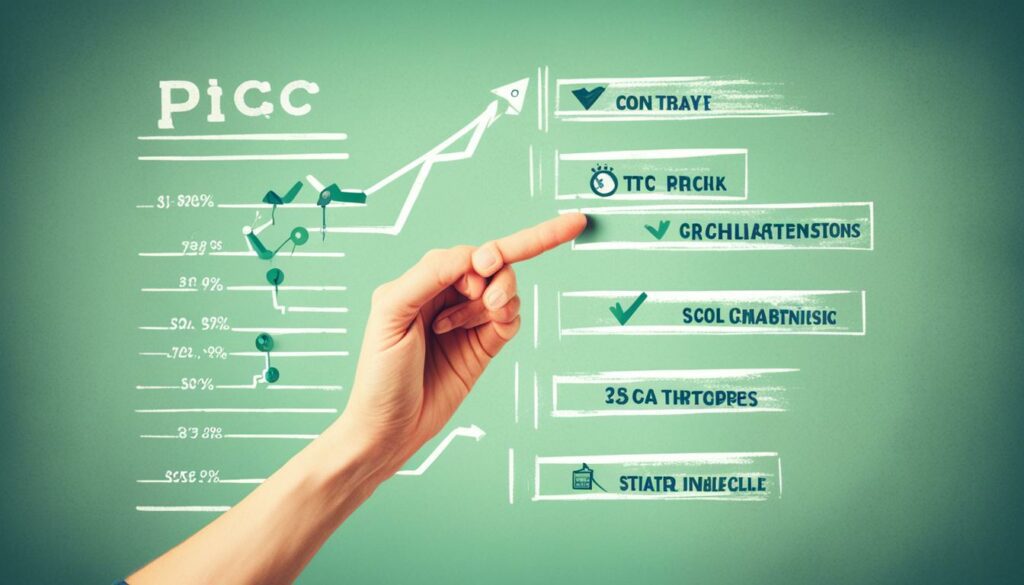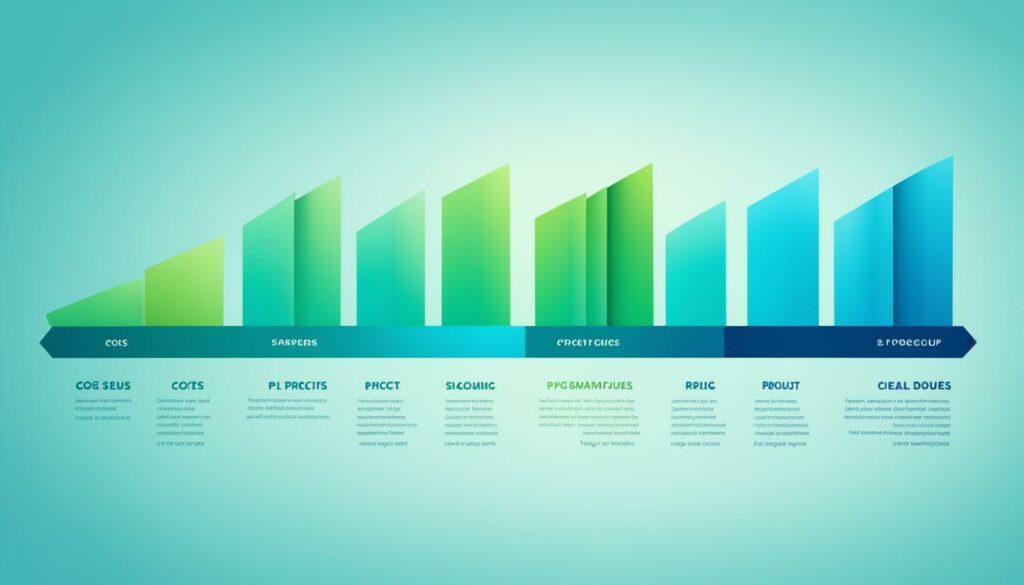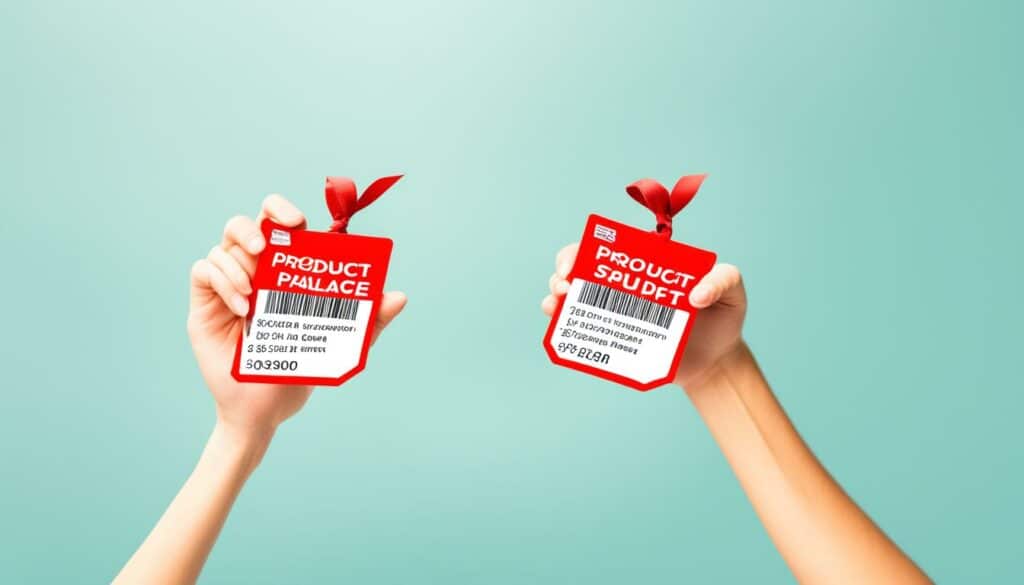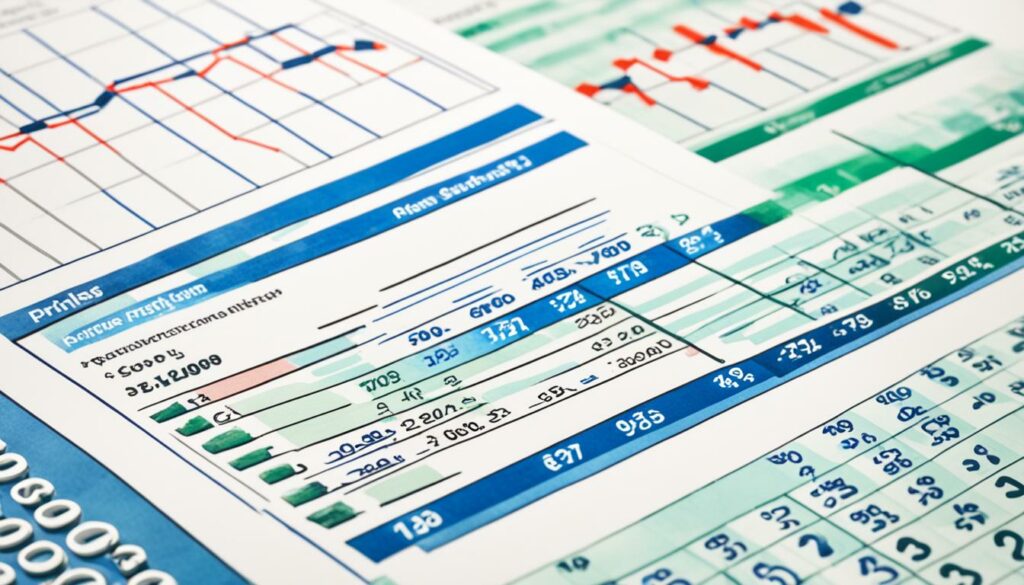Menu

Did you know that nearly 90% of the UK’s online population know the top 50 direct-to-consumer (DTC) brands? This comes from a report by IAB UK. It shows how brands like Bloom & Wild and Gousto shine in today’s market. As shopping online grows, DTC businesses connect straight with buyers. This lets them skip the old way of selling and talk directly to shoppers. Getting the right pricing strategy is super important for them to sell more and stay ahead.
Brands can really focus on what their buyers want when they talk to them directly. They can fine-tune their prices to match exactly what their buyers need and want. They are able to create special pricing plans for different shoppers and areas where they sell. This helps them not only stand out but also make good profits. When it comes to making the most of prices, changing prices quickly as buyers ask is a big win.
The Direct-to-Consumer (DTC) model is a new way for brands to sell their products. Instead of going through middlemen like wholesalers, they sell straight to people. This changes how companies talk to their customers and price their items.
With the DTC model, brands can reach their customers online. They get to control everything from how they price their items to where they sell them. This way, they can make sure their prices match their business goals.
In the growing online market, the DTC model is very important. The International Trade Administration thinks global online sales could hit $5.5 trillion by 2027. Brands like Gymshark have done really well with this approach, showing its potential. It lets brands quickly change prices to match what customers want.
The DTC model is different from usual retail because it skips middlemen. This means brands can give better prices, make more money, and offer a personal touch to customers. Nike, for example, is shifting to this model and they expect to make more money directly from customers by 2025. This shows how powerful direct selling can be.
| Aspect | Traditional Retail | DTC Model |
|---|---|---|
| Intermediaries | Multiple | None |
| Control over Pricing | Limited | Full |
| Customer Relationship | Indirect | Direct |
| Profit Margins | Reduced | Higher |
| Market Responsiveness | Slower | Fast using dynamic pricing |
DTC pricing models have benefits by cutting out the middlemen. This allows brands to set their own prices and earn more from sales. By selling directly, they can keep a tight hold on the story of their brand. That’s from when the product is made, right through to when it’s sold. This is a big advantage over traditional shops.
In direct sales pricing models, there’s no middleman. This means brands can set good prices that also make them money. For instance, a brand might sell a face serum at $20 with traditional shops. But without those shops, they can keep the same quality and price it at just $20.
They still make enough profit. This helps customers because they can buy quality skincare at a fair price.

Being able to talk directly with customers is a big deal in DTC pricing. Brands can listen and change their prices quickly. Let’s say a clothing brand starts selling leggings at $30. If people really like them, the brand might raise the price to $45. This shows how listening to customers can help a brand do well in the market.
DTC brands get to control their own branding stories. This lets them create unique brand messages and keep themselves as top choices in the market. Think of a shoe brand that sells eco-friendly shoes at $150. They can tell their story well. This includes how they’re helping the planet and why their prices are a bit higher. They can also put together special deals like a makeup set that comes with three products for $50. This can get customers interested and boost sales.
Knowing how to set prices in direct sales is key for success in a tough market. It focuses on boosting revenue and profits. This way, businesses can live long and prosper using direct customer sales to make more money.
Using the right pricing plan in direct sales can really boost a company’s money-making. By selling straight to customers and using things like personal websites, email, and social media, businesses save money. They can also get better at keeping customers. Just by keeping 5% extra customers, profits could jump by a quarter. This shows how important it is to set the right prices in direct sales.
Understand that consumers are very careful about what they spend. In direct sales, knowing what customers like and how they buy is crucial. Offering free samples or good email marketing can help win over customers. This helps move them through the buying process and meet their budgets. This understanding makes customers stick around and buy again.
Direct sales pricing must match the company’s big plans to make more money. To do this, it’s important to study the market, see what your rivals are up to, and know your customers really well. Making sure your sales and marketing work together is a must. Using social media can help you reach more customers. Offering deals, extra services, or supporting good causes can also pull in and keep customers.
The cost-plus pricing model is simple and widely used by DTC brands. It works by adding a decided percentage to a product’s total cost. This then sets the product’s final selling price.

This pricing model is easy to understand and helps DTC brands keep a steady profit. It’s good for businesses wanting stable profit margins. They ensure costs are covered and profits made through DTC sales.
Its main strength is its ease of use. By adding a mark-up on their costs, brands know they’re making a profit. This way, DTC brands cut out middlemen markups, which helps lower prices for customers.
Yet, this method has its downsides. It doesn’t react to changing market trends or consumer opinions about a product’s worth. So, if rivals are seen as offering more value, this can cause problems.
Let’s say a DTC sneaker brand makes eco-friendly shoes that cost $50 to produce. They might add a 200% mark-up. This means the shoes will be sold for $150. With this, the brand covers costs and makes a good profit.
Another instance could be a DTC cosmetics brand putting together lipstick, mascara, and eyeliner. They sell the bundle for $50, which is $10 less than if bought separately. This shows how the model maintains good profits and keeps prices competitive in DTC sales.
Here’s a table to explain this further:
| Product | Production Cost | Markup Percentage | Selling Price |
|---|---|---|---|
| Eco-Friendly Shoes | $50 | 200% | $150 |
| Fitness Apparel – Leggings | $20 | 50% | $30 |
| Cosmetics Bundle | $40 | 25% | $50 |
Knowing what consumers value in a product or service is key to effective value-based pricing. This method looks at how people see the product, not just its cost. It uses consumer views and market studies to decide on the prices. Now, let’s explore deeper into how value-based pricing works.
Value-based pricing starts by focusing on what customers think. It highlights products or services that stand out to people, making them willing to pay more. For example, those buying luxury cars might pay extra for top brands. These brands are linked with high performance, quality, and other key features. Luxury cars boost not just the buyer’s image but also personal experiences.
Effective pricing needs thorough market research. This means collecting data on what customers are truly ready to pay. Then, companies build their product’s value features based on this feedback. A good example is software-as-a-service (SaaS) businesses. They often tier their prices based on what different customers see as value. Apple also uses this approach. It prices its products high, matching the value its brand holds. This strategy is designed from lots of market research and feedback.
Let’s look at influencer marketing for a clear example. In this field, prices are set based on the influencer’s reach, audience’s perception, and the potential for brand exposure. This shows how value-based pricing can result in big price differences, allowing brands to put a lot into influencer partnerships. The same idea goes for eco-friendly brands. They often charge more for their products because customers see extra value in their ethical stance.
Value-based pricing is used in many sectors, from luxury cars to real estate and high-end products. This approach can improve a brand’s worth, loyalty from customers, and the quality of products. But, it can bring up challenges of how to keep profitable and manage all the needed resources. Yet, despite the challenges, the benefits usually win over the risks. Many companies pick this strategy to increase their revenue by better understanding what customers truly value through detailed market studies.
In today’s digital market, setting the right prices is key to a brand’s success. With Amazon alone having over 600 million products, getting pricing right is vital. Precise market analysis and smart pricing strategies are essential.

Watching what your rivals charge can really help. Tools like Netrivals can show you what others are doing. This info lets you change your prices fast to match the market and customer demand. This is especially important on big sites like Amazon and eBay.
Getting your prices right means finding a balance. You need to think about the fees the market charges, which could be up to 15%.
It’s also about choosing prices that customers see as fair, and also keeping an eye on what your competitors are doing. This approach helps keep your business making money. But, setting prices too low could mean you lose out. And being too expensive might send customers to your rivals.
Big stores like Amazon and Walmart use price matching to keep their edge. Back in November 2014, they started price matching. This move meant they could be competitive without changing all their prices. It’s a strategy that keeps their customers happy while staying in the game.
By using these pricing methods, you can make a real difference in the online market. It’s all about keeping an eye on your competition, understanding the market, and making smart changes. Doing this helps your brand keep up and succeed over time.
Penetration pricing is a strategy for brands to quickly attract customers. They do this by initially offering products at low prices. This approach helps businesses gain attention and market share fast.
It’s especially useful for new brands in crowded markets. Take StyleSavvy, for example. They start with dresses from $15 and accessories at $5, slowly raising prices as they grow their customer base.
“Penetration pricing can significantly enhance sales volumes and reduce production costs through economies of scale.”
This method works well for products where prices directly affect how much people buy. It can speed up sales and lower production costs. Yet, there’s a chance of losing money at first and customers leaving if prices go up later.
When using penetration pricing, it’s key to have a clear plan. Your strategy should fit with what customers want, aim for growth in the long term, and not lead to price battles. This way, your business can benefit for a long time, even if you start with low prices.
Big names like IKEA, MeUndies, and Amazon have used this strategy well. IKEA, with its affordable flat-packed furniture, quickly gains ground in new places.
| Brand | Penetration Pricing Strategy | Outcome |
|---|---|---|
| IKEA | Flat-packed furniture and low showroom prices | Successful market entry and increased market share |
| MeUndies | Incentives for subscription models | Significant sales growth and brand loyalty |
| Amazon | Low-priced modal-fabric underwear | Wide customer base and cost-effective market entry |
Penetration pricing works for brands both old and new. It’s an effective way to quickly get a piece of a market and win over customers with good prices at first.
Skimming pricing is about starting with high prices for new or high-demand products. Then, over time, the prices go down. This helps businesses make a lot of money quickly. They also learn who is ready to pay more for a product.

Companies like Apple and Nike are good examples of using skimming pricing. They catch the interest of early adopters. These are the people who want the newest products first. By starting with a high price, they attract these customers who see the value in being first and in quality.
Apple, for example, often launches their iPhones at high prices. This strategy is smart because it makes Apple money fast. It also gives their phones an image of being exclusive and cutting-edge.
Over time, companies have to lower their prices. This is when more people can buy their products. Also, it helps businesses stay competitive. They watch the market and listen to what customers say to choose the best time to reduce prices.
Apple is a great example of how skimming pricing works in the tech industry. They start with high prices for their new iPhones. Then, as iPhones become more common and competition increases, prices slowly drop. This makes iPhones available to more people. It’s a strategy that both makes money quickly and keeps Apple’s brand strong.
Skimming pricing isn’t perfect, though. It might make some early customers feel they paid too much. Plus, justifying high initial prices can be hard. But, with a lot of research, this strategy can help companies make more money and look good.
Bundle pricing boosts sales volume and profits. It means selling several items together at a lower total price. This motivates people to buy more items at once.
Bundle pricing gets customers to buy more by seeming cheaper. When items are grouped, it catches the eye of buyers. This makes it easier to sell a group of items than just one by one. It increases money and amount bought, giving more to customers.
Selling bundles helps get rid of stock that’s been around a while. It lets shops sell old items at a discount and still make money. This helps pay off making the product and saves space in the store. Bundles also help sell things that don’t move fast alone.
Think of a famous make-up brand. They might offer a set with a popular moisturiser, a new serum, and last year’s face mask. This bundle promotes the new serum and sells the old stock. Buyers feel they’re getting a good deal, and the brand sells more. It makes people interested in both new and old items.
Using bundles well not only sells more but makes people happy to shop that way. It grows customer loyalty and the business’s profit.
Dynamic DTC pricing lets brands change prices quickly using new tech and data. This helps them keep up with what the market and customers want. It makes them more competitive and profitable.

To start, brands use tech and data to do dynamic pricing. They gather a lot of data on the market, what customers like, and what rivals charge. For example, a skincare brand might price face serum at $20. They do this by doubling the cost. Then, they use real-time data to adjust prices right away. This makes sure they’re staying competitive and meeting what customers expect.
Being able to change prices fast means brands can keep up with what’s going on in the market. By watching trends and what others do, they can make sure their prices are right. A sneaker brand selling directly might put their’s at $150. They’re factoring in costs and that people might pay more for eco-friendly shoes. A coffee brand might charge $23 for beans if others charge $20. This small difference can make them look more premium.
Prices can also change because of the time of year and how much stock brands have. A swimwear brand might up prices as summer gets nearer. Then, lower them at the end of the season to sell leftover stock. With data, brands can decide on the best prices to help manage what they have and do better financially.
| Brand | Dynamic Pricing Strategy | Competitive Edge |
|---|---|---|
| DTC Skincare | Markup 100% on total cost | Maintains healthy profit margins |
| DTC Sneaker | Pricing at $150 for eco-friendly appeal | Appeals to eco-conscious consumers |
| DTC Coffee | Setting price slightly above competitors | Positions as premium offering |
| DTC Swimwear | Seasonal pricing adjustments | Optimises sales during high demand periods |
By using dynamic pricing and data, brands can be quick, competitive, and respond well to changes in the market.
Businesses use tricks to make us buy more. These tricks change how we see prices, making us feel they’re good deals. Understanding and using these tricks well, companies can sell more stuff.
One trick is charm pricing, where costs end in odd numbers, often with a 9. Prices like £9.99 feel cheaper than £10 because of the left-digit effect. This effect is a major force in pricing strategies, making consumers more likely to buy.
Decoy pricing is another trick. It adds a third, less attractive choice. This makes the other options seem better. It’s a powerful strategy to guide customer choice and boost sales in direct settings.
Luxury brands often use prestige pricing. They set high prices to suggest high quality, making customers pay more. This method helps luxury products maintain their exclusive feel and market position.
How a price looks can make a big difference. £12 seems cheaper than £12.00. Changing how prices appear influences our buying choices a lot.
Companies also offer discounts and bundle products in direct sales. These offers like BOGO help sell more, clear out old stock, and introduce new items. But they must be smart and listen to consumers to avoid bad feelings.
In summary, psychological pricing is all about knowing how we react to prices. By using techniques such as charm pricing and product bundling, businesses can sell more and keep customers happy and loyal.
eCommerce marketplaces like Amazon have over 600 million products. They show a need for continuous price checking. This keeps businesses on top by having the best prices.

To stay ahead on Amazon, businesses need to keep an eye on competitors. They should regularly update their prices based on market changes. This helps meet customer needs instantly.
Listening to what customers say is key to setting the right price. Talking directly to customers helps businesses understand the value they see. This way, businesses can charge prices that customers are happy to pay.
In a competitive market, businesses must keep an eye on all their costs. For example, a jewellery maker needs to think about the price of materials and labour. They also need to include other costs like shipping. Regularly checking prices helps them make a profit and stay competitive.
| Cost Type | Cost per Item |
|---|---|
| Materials | $10 |
| Labour | $5 |
| Shipping Fees | $3 |
| Packaging | $2 |
| Marketplace Fees | 15% of Sale Price |
| Advertising Expenses | $1 |
Looking at how DTC pricing success stories worked can teach us a lot. Take Dollar Shave Club. They shook up the razor market with their low prices. They offered subscriptions much cheaper than well-known brands. This won them lots of customers and loyalty.
Luxury brands also make their high prices part of their image. Rolex is a good example. They charge a lot for watches that are seen as very high quality and exclusive.
Companies like Nestle and PepsiCo have explored selling directly to consumers, too. They test pricing that can change based on what customers want and what’s available. This lets them make more money and stay popular in the changing market.
Amazon changes its prices every two minutes. This shows how critical it is for online brands to stay smart about pricing. By using lots of data and special software, Amazon makes sure they can offer the best deals without losing money.
Many fields are using dynamic pricing, from airlines to stock markets. For online brands, knowing about your customers and what your competition is doing is key. It helps them change and do well.
Consider a story where a company became a market leader in a $5 billion area. They did a lot of research, including over 50 interviews, to really understand their customers. This led to a solid plan for selling directly to customers, with a focus on the online store, payment methods, and the right prices.
Dynamic pricing has helped many sectors. It works in bars that have special prices at certain times, and in sports and healthcare industries. Despite some challenges, it’s a proven strategy for making more money.
Implementing pricing strategies in a Direct-to-Consumer (DTC) model needs clear steps. These include knowing your costs, understanding your customers, and highlighting what makes you different. This ensures your brand offers value and stays profitable.
Knowing your costs is key to setting the right prices. You need to look at how much it costs to make your product, advertise it, and run your business. Let’s say a DTC brand sells a face serum for $20, doubling the cost to ensure they make a profit. This in-depth look at costs helps brands avoid selling their products for too little.
Finding the right people to sell to is crucial. DTC brands often attract younger people and those who use the internet a lot. These customers like when companies are open and talk directly to them. It’s important to do research. For example, a company might charge $150 for a pair of shoes because they know their customers care a lot about the environment.

Standing out from other brands is important in the DTC world. This starts by understanding what makes your product special. Letting customers know this clearly is vital. A good example is a DTC coffee brand that charges $23. They do this because they have a unique way of roasting their coffee. This shows their value and convinces customers it’s worth more.
| DTC Brand | Product | Initial Price | Target Audience | Value Proposition |
|---|---|---|---|---|
| Organic Skincare | Face Serum | $20 | Eco-conscious consumers | Natural ingredients |
| Sustainable Sneakers | Sneakers | $150 | Eco-friendly consumers | Sustainable materials |
| Artisan Coffee | Coffee | $23 | Coffee enthusiasts | Unique roasting process |
| Fitness Apparel | Leggings | $30 increasing to $45 | Fitness enthusiasts | High quality and durability |
For DTC brands, mixing these key parts is critical. By understanding costs, knowing your audience, and showing your unique value, brands can stand out and do well in the competitive DTC market.
Direct sales pricing optimisation is key for DTC strategies to succeed. It’s a vital part of marketing’s 4 Ps. A strong pricing strategy not only shows the product’s value to customers. It also helps increase sales and improve earnings.
Many pricing strategies exist. These include cost-plus, competitive, and dynamic pricing. Dynamic pricing changes according to demand, competition, and availability. This ensures prices are always up to date. Moreover, Keystone pricing and MSRP are useful for certain products. They show how wholesalers and manufacturers set their prices.
Businesses must stay flexible with their pricing. They should align it with their financial objectives and market trends. An important tool is live pricing experiments. They can help find the best pricing methods through customer feedback.
There are various pricing methods, from skimming to freemium models. Each has its place in the market. By using these methods thoughtfully and evolving them, businesses can find success. It helps them grow and stay competitive in the DTC world.
Different pricing strategies work well in direct sales. You have options like cost-plus, value-based, and competitive pricing. Or, you can use strategies such as penetration, skimming, or bundle pricing.
The Direct-to-Consumer model cuts out the middlemen. It lets businesses sell straight to shoppers. This way, businesses have more say in pricing. They also get to know their customers better and can offer unique, ethical products.
Getting your pricing right is key for making money and understanding what customers want. It also helps you meet bigger business goals. Good pricing makes you more competitive and profitable.
DTC pricing is special because you deal directly with customers. You cut out the middlemen. This can mean better profit margins and more flexibility in pricing.
Cost-plus pricing means working out your product’s total cost. You then add a markup. For DTC brands, this keeps their profits steady. It also helps them offer good prices by skipping retail markups.
Brands use value-based pricing by looking at what customers think. They do market research and get customer feedback. This strategy lets brands charge prices based on what people see as valuable. It can lead to higher prices.
To do competitive pricing online, companies must know what their rivals are doing. They also need to match their prices with market trends. This ensures your prices are fair and you still make money.
Penetration pricing means starting with low prices to get customers quickly. It’s good for new businesses in a crowded market. It helps them get noticed before they start charging more slowly.
Skimming prices start high for new or in-demand products. Early buyers pay more. Then prices come down to interest more people later.
Bundle pricing tempts customers to buy more by offering good deals. It boosts sales and can clear out old stock. It’s also great for introducing new product lines.
Dynamic pricing changes your prices in real time depending on demand and other factors. By using tech and data, DTC brands can keep up and make more money.
Psychological pricing tricks our minds into thinking something is a good deal. Like, instead of £10, it’s £9. This includes buy-one-get-one offers and making prices look inviting. It makes us think we’re getting a bargain.
Regular price checks mean you’re always up-to-date with what your customers want and what the market is like. They help you do better and make more money. Listening to customers’ feedback helps you offer what they really need.
Look at Dollar Shave Club for good prices. And luxury brands that use value-based pricing. These are examples that show how different strategies can do well.
The top advice is to really know your product’s costs. Figure out who you want to sell to and what makes you stand out. This helps you set the perfect price and show customers the value they’re getting.